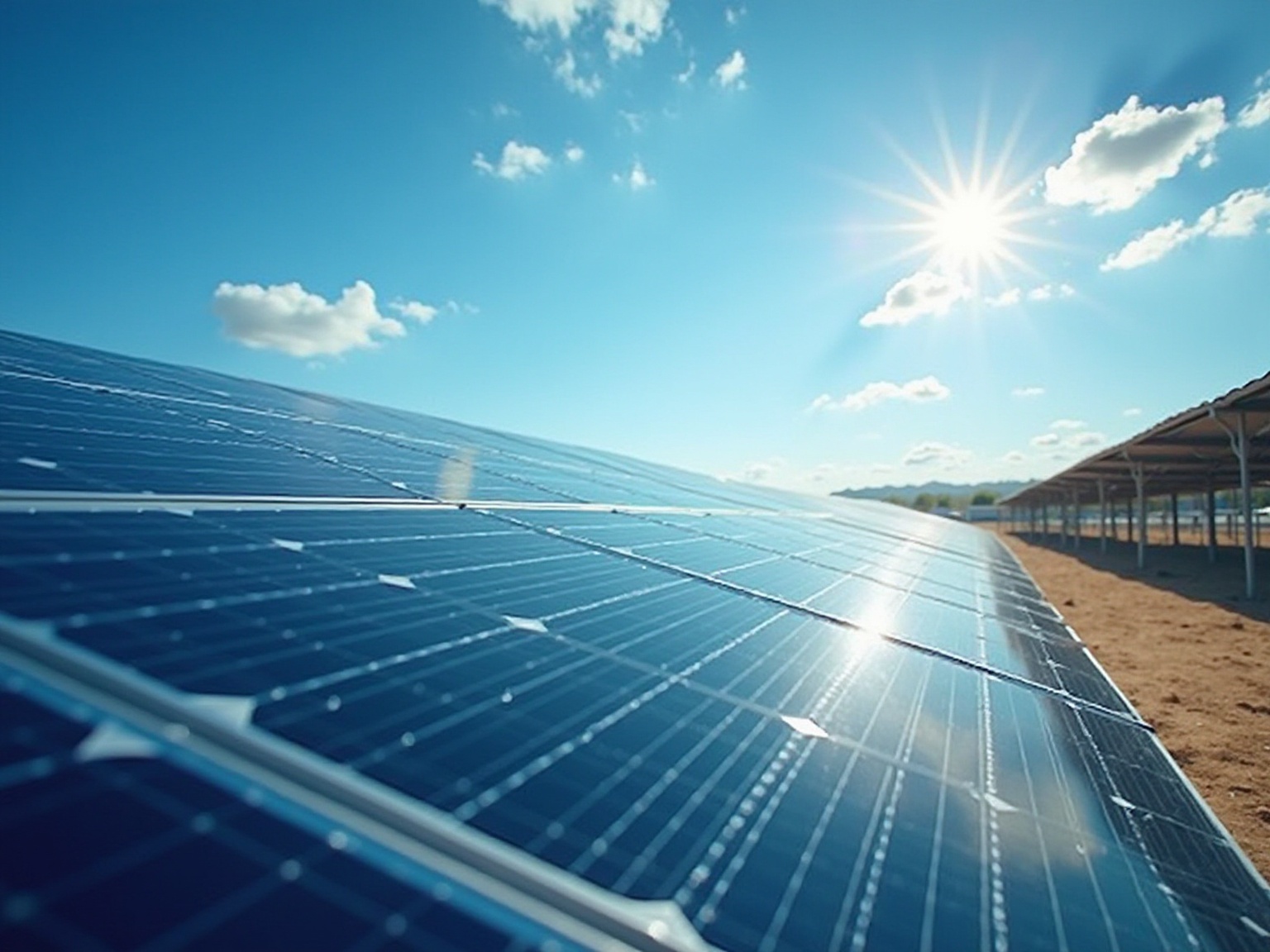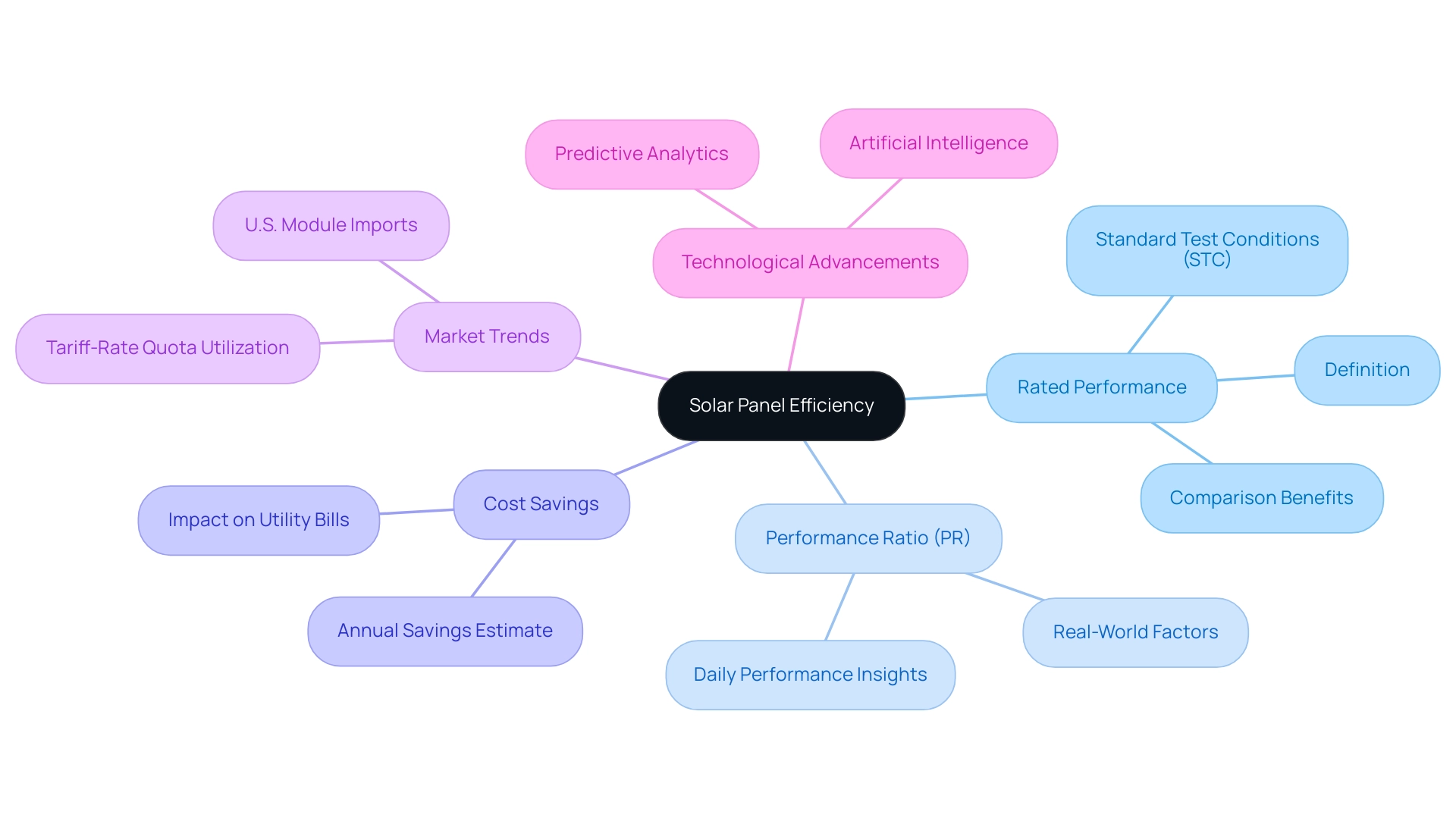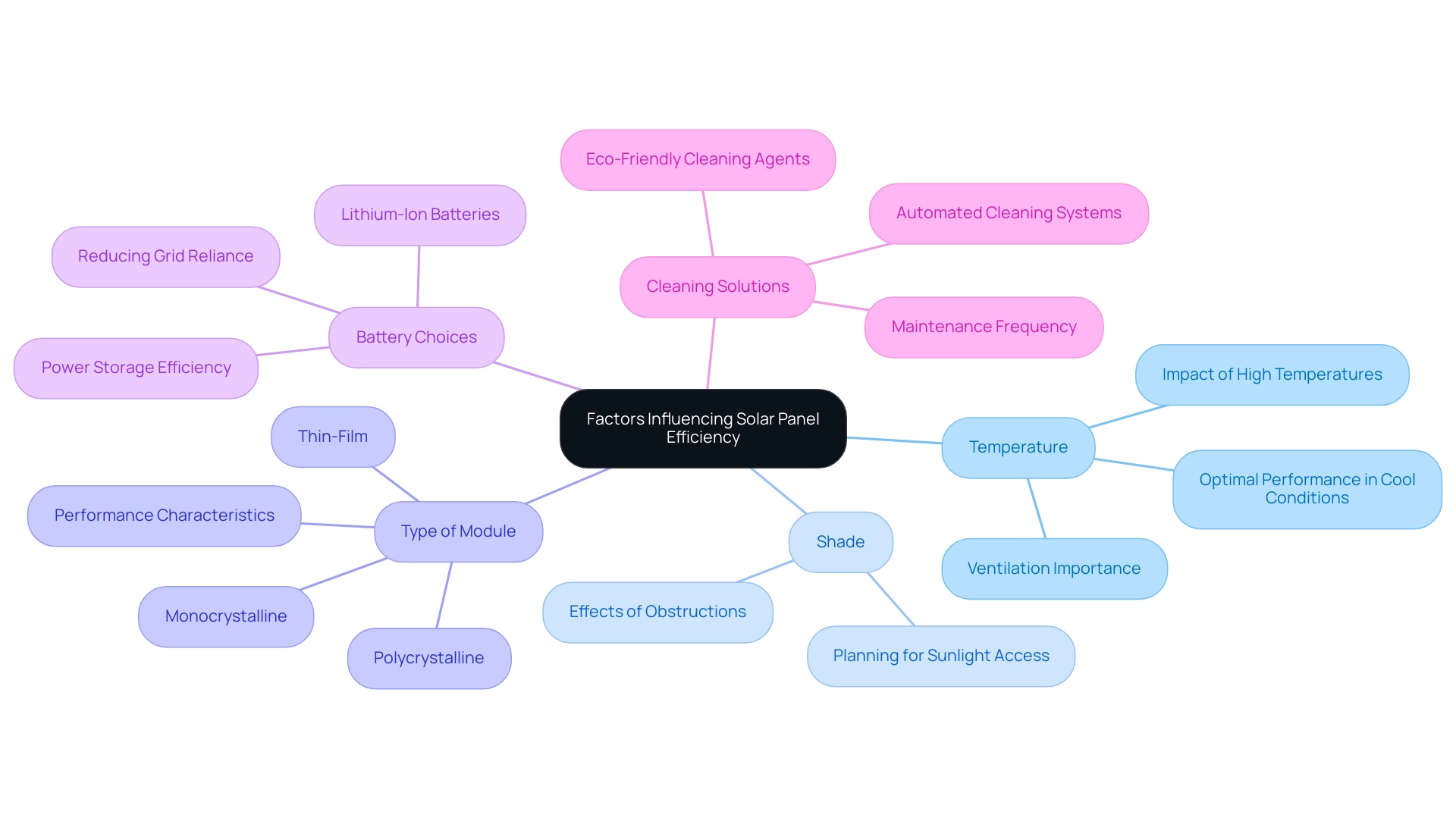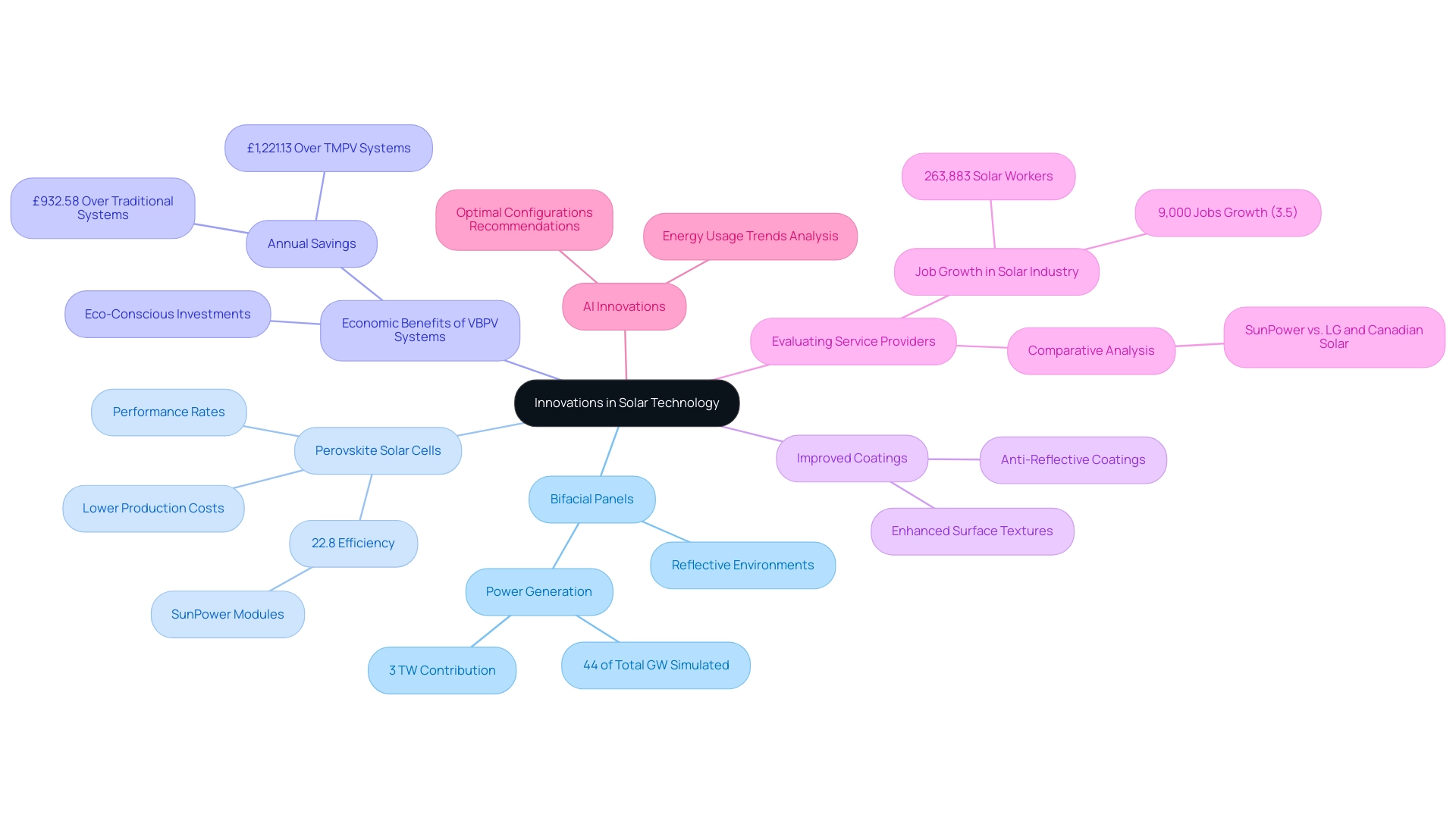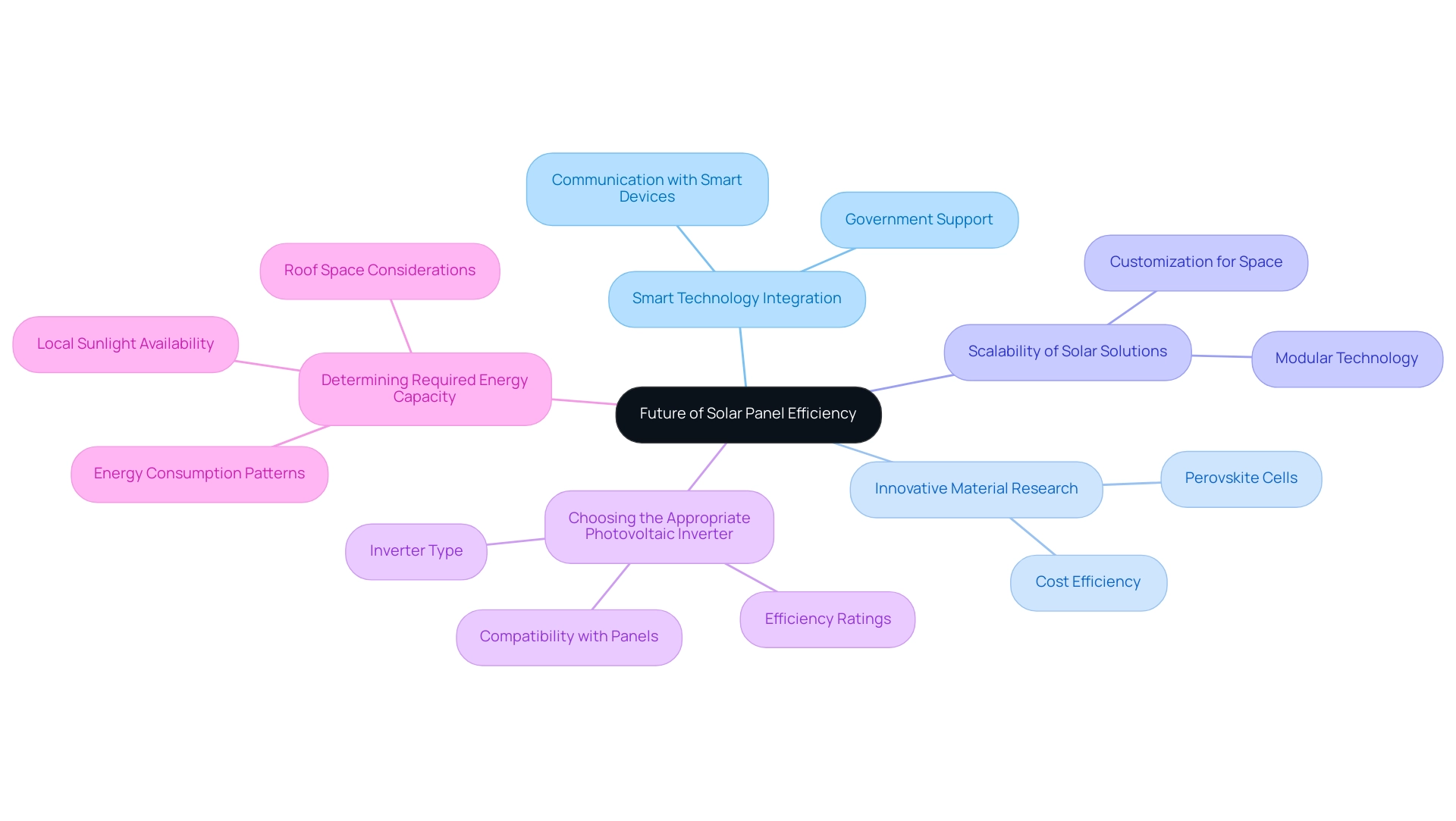Overview
Solar panel high efficiency is primarily defined by how effectively solar panels convert sunlight into usable electricity, with metrics like rated performance and performance ratio providing insights into their capabilities under various conditions. The article highlights that understanding these performance metrics, along with factors such as temperature, shading, and technological innovations like bifacial panels and perovskite cells, is crucial for homeowners to optimize their solar energy systems and achieve significant cost savings on utility bills.
Introduction
In an age where sustainability is becoming increasingly vital, understanding solar panel efficiency is essential for homeowners looking to harness the power of the sun. Efficiency, a term that often pops up in discussions about solar energy, essentially measures how effectively a solar panel converts sunlight into usable electricity.
With terms like rated efficiency and performance ratio at play, it can feel overwhelming to navigate the landscape of solar technology. However, by familiarizing oneself with these concepts and recognizing the factors that influence efficiency—from temperature and shading to the choice of materials—homeowners can make informed decisions that not only boost their energy savings but also contribute to a greener planet.
As advancements in solar technology continue to unfold, including innovations like bifacial panels and perovskite cells, the future of solar energy looks promising, offering exciting opportunities for those ready to embrace this clean energy source.
Defining Solar Panel Efficiency: Key Concepts and Calculations
When discussing photovoltaic systems, effectiveness is an important concept that homeowners ought to understand. In simple terms, the performance of solar panels high efficiency indicates how effectively a solar device transforms sunlight into electricity. It’s represented as a percentage—for example, if a system captures 300 watts of sunlight and converts that into 60 watts of usable electricity, its effectiveness stands at 20%.
Acquainting yourself with a few key concepts can make all the difference:
- Rated Performance: This reflects the highest performance a panel can achieve under standard test conditions (STC). It’s a great starting point for comparisons.
- Performance Ratio (PR): Unlike rated efficiency, which is based on ideal conditions, PR considers real-world factors such as temperature fluctuations and shading. This provides a clearer picture of how your energy system will perform daily.
In addition to understanding these metrics, it’s worth noting that investing in heating systems can lead to significant cost savings—homeowners can expect to save between $400 to $600 annually on utility bills. Moreover, 85% of installers using NREL’s SolarAPP+ permitting software report that it makes permitting significantly easier, highlighting the growing accessibility of energy installations. As climate objectives grow more pressing, as indicated by leading climate scientist Cristen Hemingway Jaynes, ‘the 2°C climate warming target is ‘dead,” it’s vital for homeowners to make informed decisions when choosing photovoltaic systems.
The U.S. module imports approached almost 15.4 GW in Q3 2024, suggesting a strong market that can affect efficiency metrics and the availability of solar panel high efficiency options. Moreover, new technologies like predictive analytics and artificial intelligence are enhancing system performance, ensuring improved output compared to input. By understanding these metrics and the current market landscape, you’ll be better equipped to evaluate the effectiveness of potential energy systems and illuminate your path toward sustainable energy.
Factors Influencing Solar Panel Efficiency: Temperature, Shade, and More
When it comes to optimizing solar panel efficiency, several key factors every eco-conscious homeowner should be aware of come into play:
- Temperature: Did you know that high temperatures can actually reduce the efficiency of your solar panels? Most systems operate optimally when it’s cool. Ensuring there’s proper ventilation around your panels is essential for maintaining performance. A study conducted at Dibrugarh University campus in Assam, India, found that on day 10 of their testing, the experimental efficiency was measured at 20.64%, showcasing how environmental conditions can significantly impact output.
- Shade: Even a little bit of shade can cast a big cloud over your energy production. It’s important to assess the placement of trees, structures, or anything else that might obstruct sunlight before you set up your units. Real-world examples have shown that shading can drastically decrease output, so planning ahead is crucial.
- Type of Module: The kind of energy collector you select is important! Various types of solar panels—such as monocrystalline, polycrystalline, and thin-film—have their own efficiencies and performance characteristics, which affect the solar panel high efficiency and how much power you can produce. Understanding these differences helps you make a more informed decision.
- Battery Choices: To maximize the benefits of your photovoltaic panels, consider investing in high-quality batteries. Choices such as lithium-ion batteries provide effective power storage, enabling you to utilize sunlight even when the sun isn’t shining. This ensures you have a reliable energy source and can reduce reliance on the grid.
- Cleaning Solutions: Regular maintenance, including cleaning your solar surfaces, is crucial for optimal performance. Innovative cleaning solutions, such as automated cleaning systems or eco-friendly cleaning agents, can help maintain efficiency without harming the surfaces. Aim to clean your surfaces at least twice a year, or more frequently if you reside in a dusty area.
By keeping these factors in mind, you can take proactive steps to enhance the performance of your energy panels and batteries, ensuring they serve you well for years to come. As one retired electrical engineer and homeowner remarked, “I could not be more pleased with the quality and care of the installation,” emphasizing the importance of thoughtful planning and execution when considering temperature and shading during the installation process. The approach employed in the research, titled ‘Experimental Setup for Panel Efficiency Analysis,’ further emphasizes the importance of these elements in optimizing your power output.
Innovations in Solar Technology: Enhancing Efficiency Through New Materials
Recent advancements in solar technology have significantly enhanced solar panel high efficiency, offering homeowners exciting options for power generation while addressing unique challenges such as shaded properties.
- Bifacial Panels: These innovative panels capture sunlight from both sides, increasing power generation, particularly in reflective environments like rooftops or snowy areas. Simulations reveal that bifacial modules account for nearly 3 TW of power generation, comprising over 44% of the total gigawatts simulated in RatedPower.
This significant contribution highlights the increasing significance of bifacial technology in the overall energy framework, resulting in more energy for your home and possibly reduced electric bills.
- Perovskite Solar Cells: Emerging as a groundbreaking new material, perovskites promise greater performance rates and lower production costs. Experts believe these cells could transform energy technology, making it more accessible for homeowners. As noted by Emily Walker, SunPower provides solar panel high efficiency photovoltaic modules for residences today at 22.8% efficiency, highlighting the competitive landscape of renewable energy technology and its impact on Palo Alto homeowners seeking effective solutions.
- Economic Benefits of VBPV Systems: An economic analysis of VBPV systems indicates they can lead to significant financial savings, with estimated annual savings of £932.58 over traditional systems. This analysis not only emphasizes the economic advantages but also aligns with the interests of eco-conscious homeowners looking to optimize their investments in power.
- Improved Coatings: The development of anti-reflective coatings and enhanced surface textures is another area of innovation, designed to maximize light absorption and minimize losses during conversion. These advancements ensure that your solar panel high efficiency enables them to operate more intelligently, not with more effort.
- Evaluating Service Providers: As of December 2022, the industry in the U.S. has experienced a growth of nearly 9,000 jobs (3.5%) since 2021, reflecting the broader impact of innovations in technology. This growth not only benefits the economy but also supports the shift to renewable sources, reinforcing the relevance of these innovations to eco-conscious homeowners. Selecting the appropriate supplier can further improve your renewable power experience. For example, contrasting SunPower’s superior effectiveness with other suppliers such as LG and Canadian Solar can assist homeowners in making knowledgeable choices based on performance and expenses.
- AI Innovations: The incorporation of AI technologies in renewable solutions is changing how homeowners optimize their power consumption. AI can examine energy usage trends and recommend the optimal configurations for renewable energy systems, ensuring peak performance and savings.
By monitoring these advancements and assessing service providers, you can select the most effective solutions available, enhancing both your energy savings and environmental influence.
Maximizing Solar Panel Efficiency: Best Practices for Installation and Maintenance
Enhancing the performance of your energy systems is crucial for obtaining the greatest return from your investment. Here are some friendly tips to help you achieve optimal performance:
- Proper Installation: It’s crucial to ensure your energy collectors are installed at the correct angle and orientation. For the best power output, aim for a tilt angle of 26°, which allows for maximum sunlight capture throughout the day. As Emily Walker highlights, SunPower provides solar panel high efficiency energy collection systems for homes today, achieving an impressive efficiency of 22.8%, so selecting a high-quality unit is also essential. Additionally, consider that the solar module used in our investigation had a maximum power of 100 W, which illustrates the performance capabilities you should look for when selecting your system.
- Regular Maintenance: Keeping your modules clean is vital. Dust, dirt, and debris can significantly affect their performance by blocking sunlight and hindering energy production. Make it a habit to clean your surfaces periodically and don’t hesitate to schedule professional inspections to catch any potential issues early. Remember, research shows that even slight performance declines can accumulate over time, with data indicating a median loss rate for photovoltaic system performance of 0.75% per year. Moreover, with over 18% of U.S. renewable energy capacity now having a corporate offtaker, it’s important to stay informed about procurement strategies that may impact your maintenance decisions, such as community projects and green tariffs. Interestingly, researchers from the Indian Institute of Engineering Science and Technology have developed a model to estimate dust accumulation on photovoltaic surfaces, taking into account factors like particulate matter concentration and tilt angle, which can help optimize maintenance schedules.
- Monitoring System Performance: Implementing monitoring tools can help you track energy production. By keeping an eye on your system’s performance, you can quickly identify any drops in output, enabling timely troubleshooting and adjustments. Insights from our case study on photovoltaic system performance analysis highlight the importance of monitoring environmental factors like sunlight intensity and temperature, which can greatly influence effectiveness.
By adhering to these best practices, homeowners can not only enhance the productivity of their energy systems but also extend their lifespan. Remember, keeping your energy collectors clean and well-maintained plays a crucial role in achieving a more sustainable and environmentally friendly home.
The Future of Solar Panel Efficiency: Trends and Research Directions
The future of solar panel efficiency is looking brighter than ever, driven by several exciting trends that homeowners can look forward to:
- Smart Technology Integration: Imagine having solar systems that not only harness sunlight but also communicate with your smart home devices! This integration optimizes power usage and provides real-time data on your production and consumption, giving you more control over your home’s efficiency. Plus, government programs are increasingly supporting the adoption of such technologies, making it easier for homeowners to transition.
- Innovative Material Research: Researchers are making strides with materials like perovskite cells, which aim to produce cheaper and more efficient panels. This innovation could significantly influence homeowners in regions such as Palo Alto by making solar panel high efficiency technology more attainable and affordable—truly a win-win for both the planet and your finances.
- Scalability of Solar Solutions: With advances in modular technology, homeowners now have the flexibility to customize their installations to fit their unique needs. Whether you possess a small urban rooftop or a spacious suburban yard, scalable solutions can adjust to your space and resource demands, all while adhering to California’s building codes that promote sustainable practices.
- Choosing the Appropriate Photovoltaic Inverter: Picking a photovoltaic inverter is vital for optimizing your power system’s performance. Homeowners should consider factors such as inverter type, efficiency ratings, and compatibility with their panels to ensure optimal performance.
- Determining Required Energy Capacity: To ascertain how much renewable energy you need for your home, consider your energy consumption patterns, roof space, and local sunlight availability. Devices such as calculators powered by sunlight can assist in estimating the suitable system size customized to your specific requirements.
These trends not only indicate a vibrant future for photovoltaic technology but also suggest that homeowners can expect enhanced efficiency and performance due to solar panel high efficiency in the years to come. With the U.S. photovoltaic capacity already at an impressive 219.8 GW and projections for ongoing growth—BNEF predicts an increase to 592 GW by 2024—there’s never been a better time to explore this renewable source. Additionally, the case study titled “Future Projections for US Energy Sector” highlights anticipated growth of 40.5 GW in 2024, despite challenges like labor availability and equipment constraints, which underscores the dynamic nature of the energy industry.
Moreover, understanding the economic and environmental benefits of solar heating systems, including both active and passive solutions, can further enhance your energy efficiency and sustainability efforts.
Conclusion
Understanding solar panel efficiency is essential for homeowners eager to make informed decisions about harnessing solar energy. Key concepts such as rated efficiency and performance ratio provide valuable insights into how effectively solar panels convert sunlight into usable electricity. By recognizing the factors influencing efficiency—like temperature, shading, and the type of panel chosen—homeowners can optimize their systems for maximum energy savings and environmental impact.
Innovations in solar technology, including bifacial panels and perovskite cells, promise to enhance efficiency and accessibility, making solar energy a more viable option for a broader audience. As the market continues to evolve, staying informed about these advancements can empower homeowners to select the best solar solutions tailored to their needs.
To maximize solar panel efficiency, best practices in installation and maintenance are crucial:
- Ensuring proper installation
- Regular cleaning
- Monitoring system performance
These practices can significantly extend the lifespan of your solar investment. As the future of solar technology unfolds, embracing these trends not only benefits individual households but also contributes to a more sustainable and greener planet for all. Now is the time to take action and explore the potential of solar energy to illuminate a brighter, cleaner future.


